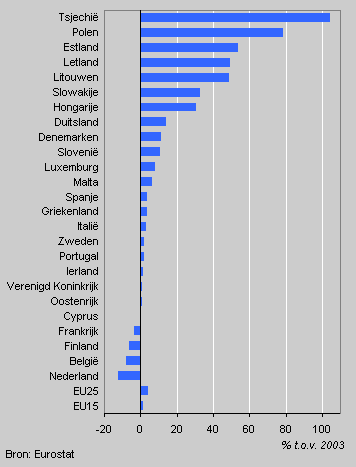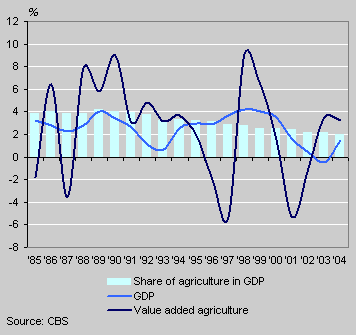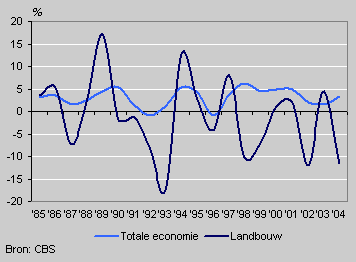Dutch farmers generate less income

Income from agriculture in the Netherlands was 12 percent lower in 2004 than in 2003. This decrease is the largest of all EU member states. Income from agriculture also fell in France, Belgium and Finland. In the other member states it rose.
Growth in income from agriculture, 2004

More income from agriculture in accession countries
The average income from agriculture in the EU rose by 4.4 percent in 2004. The growth was mainly generated by the accession countries. In most of the new member countries income from farming has rocketed in 2004 with the substantial increase in subsidies. In the Czech Republic, for example, the income of farmers even doubled through these payments.
The considerable increase in faming income in the EU has been accompanied by a decrease in employment in the sector of 2 percent. In the Netherlands the labour volume in agriculture also fell by 2 percent.
Lower prices, higher costs
In the Netherlands the decrease in income from agriculture in 2004 was mainly caused by lower prices for produce and higher costs of intermediate consumption. On average, selling prices of agricultural products fell by 4 percent. Horticulture in particular has been confronted by substantially lower market prices. Fresh vegetables were sold for 19 percent less, fruit for 10 percent less and flowers and plants fetched 6 percent less.
Horticulture has been the branch that has kept agriculture in business in the last few years, but this situation seems to have come to an end in 2004. Nearly half of agricultural income is generated by horticulture . In 2004 this branch accounted for 15 thousand of the 90 thousand businesses in agriculture.
GDP growth, value added of agriculture and share of agriculture in Dutch GDP

Positive contribution to economic growth
In spite of the decrease in income from agriculture in 2004, the volume produced by farmers rose by 1.5 percent in 2004 compared with 2003. This growth was partly caused by the relatively small production volumes in 2002 and 2003. Livestock farmers, for example, were affected by the fowl pest outbreak, while arable farmers suffered disappointing crops as a consequences of the warm dry summer.
Agriculture recovered from these setbacks in 2004 with top crops for cereals and seed onions and substantial production increases for poultry (+12 percent) and eggs (+32 percent). In addition, the volume of plants and tree nursery products rose by 7 percent. Value added was a net 3 percent higher in 2004 than in 2003. This growth rate is significantly higher than at that of the economy as a whole as estimated by the Netherlands Bureau for Economic Policy Analysis, which puts economic growth at 1.5 percent in 2004.
Economic significance of agriculture halved
In the last 20 years Dutch agriculture has performed just as well as the overall Dutch economy, with an average growth of 2.5 percent per year. On the other hand, labour volume in agriculture has fallen by an average 0.8 percent per year.
The share of agriculture in the total economy fell from 4 percent in 1985 to 2 percent in 2004. The main reasons for this were the large productivity increase and the less favourable price development in agriculture compared with the rest of the economy. This pushed down agricultural income per fte by an average 1 percent a year in the last two decades, while the income per fte in the economy as a whole rose by 3 percent.
Growth of real agricultural income per fte in the Netherlands

Ron van der Wal (CBS) and Boudewijn Koole (LEI)